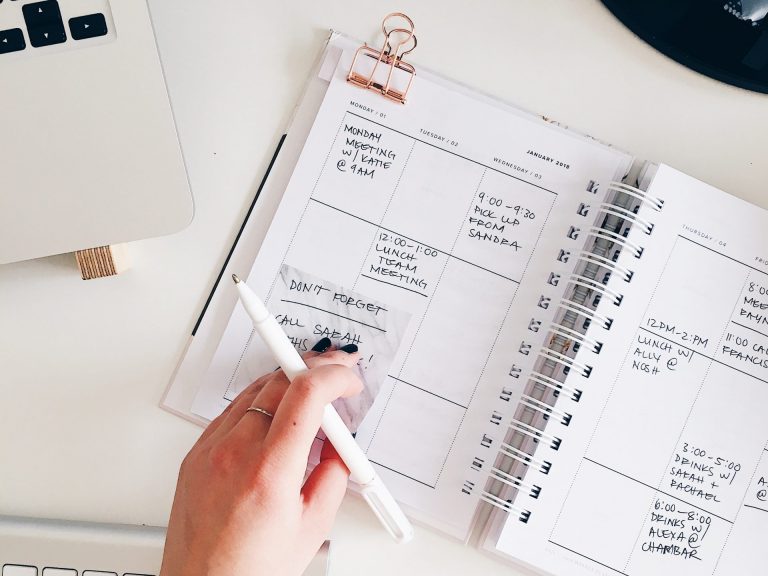An average person spends around 30% of their days sleeping and 40% being unproductive. With roughly 7 hours left to tackle your tasks, it is not surprising that you always feel like you haven’t done enough. That happens because you’re not scheduling your day for maximum productivity.
Most people attribute productivity to sleeping less, working more hours, and abdicating breaks and free time. They think leisure and rest are antonyms of productivity. But the reality couldn’t be further from that!
Productivity is making time work in your favor. It happens by choosing priorities, knowing your highs and limits, and learning to respect your body while building self-discipline.
It’s too naive to say we all have the same 24 hours a day, but we can definitely improve how we spend our days regardless of our lifestyles. Learn how to do so with our step-by-step to schedule your day for maximum productivity.
Scheduling your day will change your productivity game
Following a schedule is the best way to make the most of such a limited resource as time. Leaving your days up to chance will make them fly by while you continue to feel like the hours in a day are never enough.
Planning what you’ll be doing, knowing what resources you need, and when you are sitting down to get something done puts your mind at ease.
Avoid wasting time
Procrastination and distractions are usually a result of a lack of planning. When you have a concise schedule to follow, it is easier to stick with what you really need to get done.
A schedule that maximizes your productivity is balanced. You’ll still have time to scroll a bit through social media or take a short nap after lunch. By following the plan, you can make time for everything you need!
Increase satisfaction
Schedules can be a good thing, even if you’re a very spontaneous person and not much of a fan of routines. Having some sort of structure for your day can increase your satisfaction with your productivity and performance for the day.
Plus, your schedule doesn’t have to be the same every single day. As long as you take the time to plan the next day and commit to the plan, you can change it up to your liking.
Relieve stress and anxiety
When it comes to work, we’re usually stressed in the mornings before we start and anxious about the next day in the evenings. That happens because we’re not getting the tasks out of our heads by not finishing or at least planning them.
Writing down all your to-dos and putting them in a calendar can be a game-changer for your peace of mind. You won’t spend any more nights worrying that you’ll forget to do something the next day.
Improve productivity
All the previous advantages of keeping a schedule result in much-improved productivity. That happens because you’ll be using your time smartly, will be happy with your performance, and will always have a fresh mind to start working on something new.
But how to achieve that? It’s more straightforward than it seems. Next, we’ll walk you through 5 simple steps to help you build an effective schedule for maximum productivity.
Learn more: 3 Time Management Techniques To Try Today
5 steps to schedule your day for maximum productivity
1. Define a time to start and stop working
The first step to start designing your daily schedule is knowing when you’ll begin and wrap up work each day. Although following a repetitive routine can do wonders for your productivity, if this is not your style, you can just decide when to start and stop working the day before.
Defining the time frame of your work shift is essential to separate work time from personal time. If you decide to work from 9 a.m. to 5 p.m., you know that you can plan personal responsibilities before and after that. You’ll also learn that you must complete all work tasks by 5 p.m. and schedule any leftovers for the following days.
By setting clear time frames for work, you’re more likely to respect your time for family, leisure, and rest. You’ll learn to turn off any work-related thoughts and will be much more energized for a new shift the next day.
2. Set your priorities
We can only fit so much in a day. Both in your personal and professional lives, you’ll have to choose your priorities and maybe sacrifice some things here and there.
Take some time to list the things you must do and rank them by urgency and importance. You’ll need to make some sacrifices in order to create a balanced schedule for maximum productivity.
Regarding work, you might want to consider the time spent in meetings, strategic planning, operational tasks, emailing, etc. In your personal life, you may want to define your key daily activities and how much time you can spend on them.
3. Track the time spent on tasks
At first, you’ll need to estimate how much time each task will take, but you’re likely to get it wrong. We usually think things take less time than they actually do.
Because of that, it’s essential to start tracking the time you spend on each task. Knowing precisely how much time you need to spare for your chores and assignments will make your schedule more accurate and much easier to stick to.
Tracking your tasks will also help you to optimize the time spent on distractions and meaningless activities, such as mindlessly scrolling on social media or binge-watching Netflix mid-week.
4. Work on improving your focus
The downfall of a productive schedule is designing it to make you work more when all you need is to work smarter. Instead of trying to fit more work hours into your day, you need to learn how to make the most of less time.
The best approach to that is learning to improve your deep focus. Most of our time is wasted on distractions or shallow activities. When you understand how to cut back on such time killers and focus on meaningful activities, you’ll be able to do much more in less time.
But don’t fool yourself: the extra time you’ll gain with deep focus shouldn’t be spent on work. Use that time to take care of yourself and get ready to give your best again the next day!
5. Pick practical scheduling tools
You can definitely use paper planners and calendars to design your daily schedule, but digital tools can often do a much better job in less time. In addition to Akiflow, you can enhance productivity by automating repetitive tasks with tools like Blaze Today, which help streamline workflows effectively.
With Akiflow, you can pull all your tasks from your most-used apps and schedule them by priority in a single platform. You won’t waste time juggling between tools and won’t miss another deadline or event anymore.
With a unified task list and calendar view, it’s easy to drag and drop the tasks onto the desired time frame. You can set the task duration, deadline, priority, and description. Using the labels is also a great way to categorize each type of task.
You can use the Focus Mode to improve your concentration by creating a visual anchor of the current task you’re working on. This feature hides the to-do list to avoid diverging your focus to other assignments and reducing anxiety caused by a full inbox.
Akiflow is a time blocking app that also helps you prepare for a new work shift and turn off from it by the end of the day with the Daily Planning and Shutdown rituals. At the beginning of each day, it guides you to organize your schedule. The app will then help you clear your mind and decompress by the time of wrapping up work.
You can start using Akiflow for free today!
Wrapping up
Time is a valuable yet limited resource. We must all learn our ways through planning and scheduling to make the most of our time.
Scheduling our day helps us avoid wasting time, reduce anxiety, and increase our productivity and satisfaction with work and life. With realistic standards and some adjustments to our personal routines, scheduling can be a great ally to becoming the best versions of ourselves.
Thinking of giving daily scheduling a go? You can have a much smoother experience with Akiflow. Try it for free now!

How Strategic Planning can Affect your Productivity
Like all the other good things in the world, productivity cannot be achieved simply either. Without strategic planning, it is highly unlikely that you will employ the utmost productivity you can have at work. What is good to notice here is that you can easily level up your productivity if you know what a crucial […]

Do or plan: staying on top of things with a simple strategy
Given the number of inputs that we receive every day, both in our work and personal lives, it can be difficult to stay on top of everything. Over the years, I have developed a simple strategy that helps me to stay focused, never miss anything, and, ultimately, get things done. In short, my strategy is […]

Best Task Management App For 2023
Have you or your team been struggling to effectively plan and deliver tasks on time? If you’re often missing key deadlines or falling short of effective collaboration, you could benefit from task management software. Task management apps allow you to track time, manage a plethora of tasks, and collaborate efficiently with a wider team. The […]

